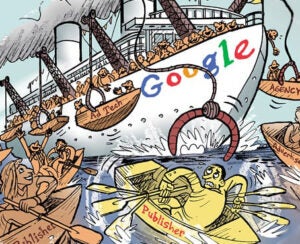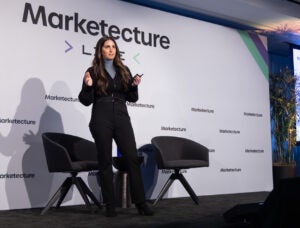 Marketers need to fundamentally rethink the traditional purchase funnel if they want to effectively target media and messaging in the future, says Kate Sirkin, EVP and global research director of Starcom MediaVest Group (SMG).
Marketers need to fundamentally rethink the traditional purchase funnel if they want to effectively target media and messaging in the future, says Kate Sirkin, EVP and global research director of Starcom MediaVest Group (SMG).
Leading a discussion at Publicis Groupe’s New York headquarters Thursday alongside social analytics agency Mashwork, Sirkin discussed how social data is unlocking additional opportunities for marketers in the shades of gray and nuance that now characterize the customer journey.
“In-the-moment declarations are a big deal,” she said. “When we [conducted a 12-month] auto [category] study, we realized nearly 8,000 people were exclusively talking about car purchases or checking in to auto dealerships every day. You’ve got the visual identity of those individuals and if you can add them to your CRM database, or understand which days, weeks, times of week they’re in market, it’s critical.”
She added, “As we think about data, and we look at the unit sales of cars over a period of a year, and then we look at the consideration and purchase conversations over social, these are critical elements to apply to traditional media decisions.”
Sirkin later sat down with AdExchanger to talk broader data trends, metrics and channel convergence.
AdExchanger: Google teamed up with comScore to pipe Validated Campaign Essentials (vCE) metrics into its DoubleClick ad server. What’s the status of real-time metrics for marketers?
KATE SIRKIN: I think we’re getting there. I don’t think we’re 100% there yet. The neat thing about the Google-comScore partnership is it’s going to feed the data into the systems people are using for their buying. It will help drive the day-by-day optimization of the ad server alongside the audience measurements. Until that is up and running, people are using so many different systems and they’re trying to pull it together. It’s a big change to the workflow.
Right now I think people are using it for month-by-month optimizations, and then for post-campaign analysis, where in traditional media, that’s how you would have used it. But I think for the real promise of it, it needs to be much more integrated into workflow and I think the Google-comScore deal will certainly help drive that from SMG’s perspective.
ComScore also linked up with data companies Acxiom, Epsilon and Batanga Media. Has this magnified their abilities?
Yes, and I think Nielsen is doing the same thing with Facebook. I think, at the beginning, the industry needed to start somewhere and bless Nielsen for doing it with Facebook in the beginning. That was the biggest and most scalable option. But as time goes on, you realize that’s not the only answer. That’s no good for multicultural or any rich, strategic target, but they’re expanding, and comScore’s expanding and I would love for it not to be a monopoly solution because monopoly drives nothing. Competition drives innovation. … From our standpoint, there are options to test [metrics] every week, and we have to be able to at some point have a clean test, so we can’t be involved in everything.
Have TV dollars shifted to online? How can that happen?
We follow the consumer. If the millennial consumer is watching the latest “Big Bang Theory,” that’s where advertising and the ad format needs to evolve as well. Right now, it’s still a little clunky I think. But measurement[s] like OCR and vCE are helping us understand how to play that out better. If you think about both Facebook and Twitter and the conversation around TV shows, and which show has the most conversation about auto or packaged goods or beauty, it’s “How do we work with Facebook and Twitter to amplify and target messages to people who are talking about those shows within the context of the broader advertising campaign?”
During the panel, you talked about resources needed to activate audiences against large-scale social data.
At the beginning of the influx of social data, it was a question of “What do I do with it?” There’s all this real-time social data and people would go in and browse for hours. [Marketers] didn’t know what to do with it. It’s not a “Go in and look thing” anymore. It’s insights, measurement, and activation. And we’ve pulled those data sets and built internal tools to help us do that.
What’s top of mind for you right now?
Spending 25 years in fairly traditional media and marketing research, I’m excited at the ability of social data to expand that, and make marketing richer, more scalable, more real-time. We started to look at how our brands are performing through each stage of the customer journey and put media and marketing goals against those. We also spend a lot of time talking to our content providers and then thinking about how we can use the data in all of these various ways and use it within our activation teams to start to amplify some of the messages people are sharing in social media to reach our whole audience, [including consumers who aren’t on social] through [mediums such as] television.













